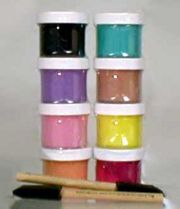Liquid latex
Liquid latex is a self-curing latex product. It is purchased in liquid form, applied to the desired surface and allowed to set to a solid state[1]. Liquid latex is available in many different colours; it can also be obtained in fluorescent or metallic colours. Liquid latex is popular among latex fetishists for its "second skin" effect when dried after application to the body. It is also commonly used in the special effects industry.
Applying Liquid Latex
When applying liquid latex to the body, it can simply be painted on. The latex can be peeled off easily when dry. In order to achieve the best appearance on the body, multiple coats of liquid latex are recommended. If the drying process needs to be accelerated, a hair dryer may be used. When applying liquid latex to the body, a shaved or waxed skin surface is recommended; hairs may be pulled off when the latex is removed, which can be painful.
Liquid latex can also be used to rubberise fabric garments. Rubber-coated clothing can be created by dipping fabric into, or painting it with, the liquid latex. Non-stretch absorbent material and elastic stretch materials are recommended for this process. To create a moulded rubberised garment, apply liquid latex to the fabric while it is being worn.[2] [3]
One practical home use of liquid latex is as a non-slip coating for furniture and rugs.
Precautions When Using Liquid Latex
The process of application can be very messy, so proper protective precautions are recommended. Liquid latex may be difficult to remove from clothing or upholstered furniture. Liquid latex my have a faint ammonia smell, so those sensitive to ammonia vapours should use caution.
See also
| This page uses content from LatexWiki (see here); the original article may be viewed here. |

